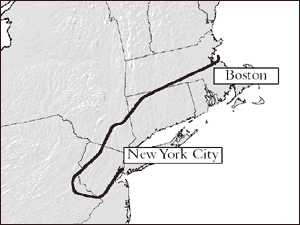The Hijackings
part 1 2 3 4 5 6
NEADS was still trying to find American 11 when they learned it had hit the World Trade Center.
The military had trouble tracking American 11 because the hijacker pilots had turned off the plane's transponder. A transponder emits a signal that tells air traffic controllers where a plane is. Controllers had to use radar to find the plane, and radar isn't as good as a transponder. It doesn't give the plane's ID, or its altitude.
The air traffic controller was trying to find American 11, so he didn't notice at first that another plane assigned to him was also acting strangely. By coincidence, the same air traffic controller in New York was assigned to the first two planes that were hijacked - American 11 and United Flight 175.
United Airlines Flight 175 - Boston to Los Angeles
 |
8:14 Takeoff
8:42 Last radio communication
8:42 to 8:46 Likely takeover
8:47 Transponder code changes
8:52 Flight attendant notifies UA of hijacking
8:54 UA attempts to contact the cockpit
8:55 New York Center suspects hijacking
9:03:11 Flight 175 crashes into 2 WTC (South Tower)
9:15 New York Center advises NEADS that UA 175 was the second aircraft crashed into WTC
9:20 UA headquarters aware that Flight 175 had crashed into WTC
From 9/11 Commission report |
Eventually, he noticed that someone had turned off United 175's transponder. He tried to contact the plane, but there was no response.
The controller-in-charge told a manager that she believed United 175 had also been hijacked. According to the report, "The manager tried to notify the regional managers and was told that the managers were discussing a hijacked aircraft, presumably American 11, and refused to be disturbed. "
Similarly, national FAA officials were focused on American 11. A manager from the regional air traffic center in New York called the national FAA Command Center in Herndon, Virginia, which oversees the regional air traffic centers. The commission heard tape of that conversation:
MANAGER, NEW YORK CENTER: We have several situations going on here. It's escalating big, big time, and we need to get the military involved with us.
COMMAND CENTER: We're - we're involved with something else. We have other aircraft that may have a similar situation going on here.
The staff report goes on to say:
Evidence indicates that this conversation was the only notice received prior to the second crash by either FAA headquarters or the Herndon Command Center that there was a second hijacking.
While Command Center was told about this 'other aircraft' at 9:01, New York Center contacted New York terminal approach control and asked for help in locating United 175.
TERMINAL: I got somebody who keeps coasting but it looks like he's going into one of the small airports down there.
CENTER: Hold on a second. I'm trying to bring him up here and get you - there he is right there. Hold on.
TERMINAL: Got him just out of 9,500-9,000 now.
CENTER: Do you know who he is?
TERMINAL: We're just, we just we don't know who he is. We're just picking him up now.
CENTER (at 9:02): All right. Heads up man, it looks like another one coming in.
The controllers observed the plane in a rapid descent; the radar data terminated over lower Manhattan. At 9:03 and two seconds, United 175 crashed into the south tower.
Continued: part 4
| 
